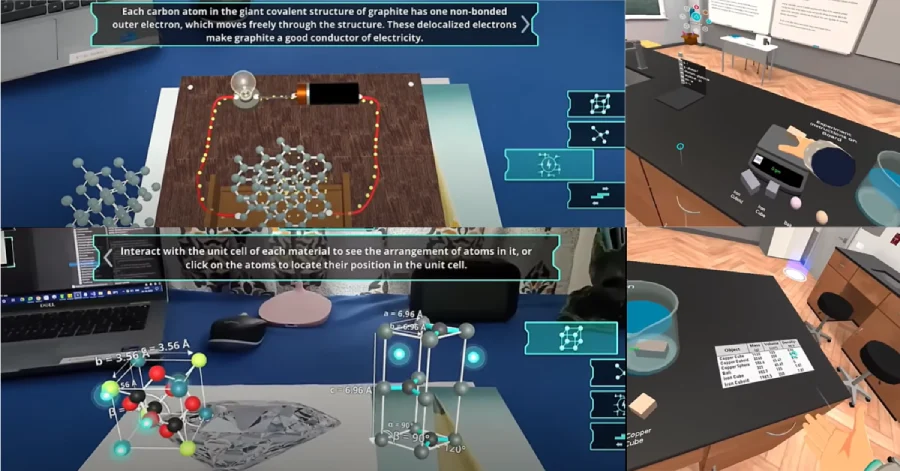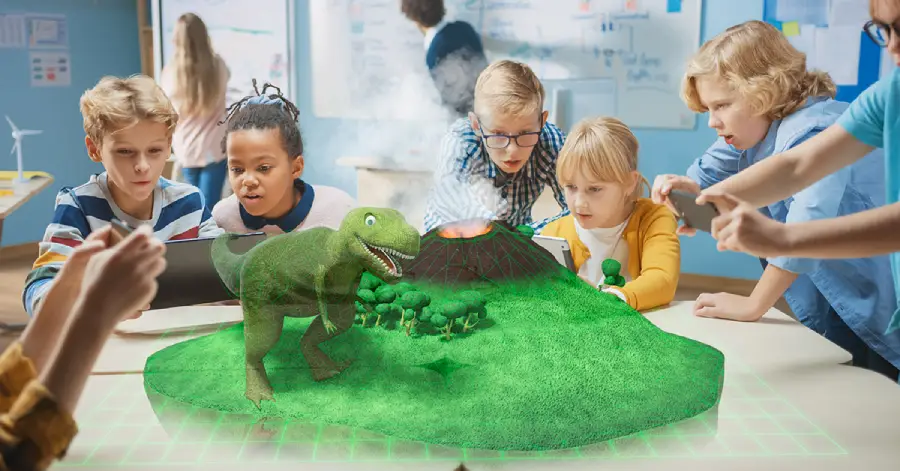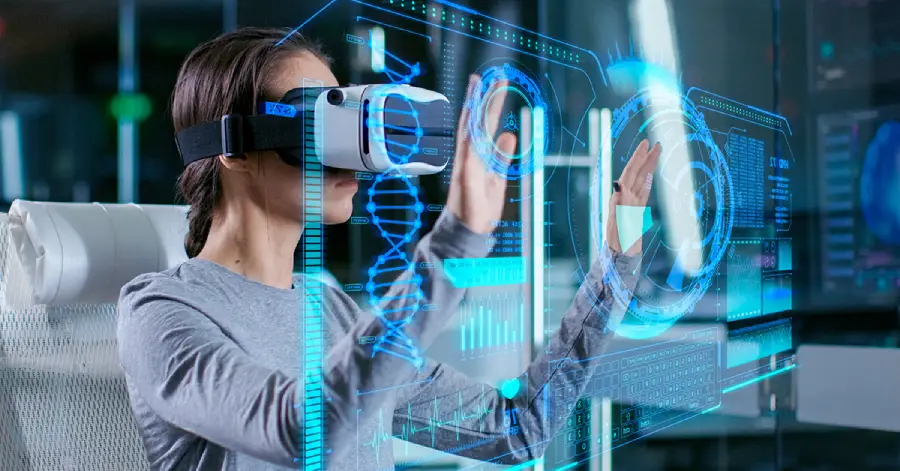The Ultimate Guide to Virtual Labs
- Published on: January 4, 2022
- |
- Updated on: June 26, 2025
- |
- Reading Time: 6 mins
- |
-
Views
- |
What are virtual labs?
Importance of Virtual Labs in Education
1. Enhancing Learning with Visual and Interactive Elements
2. Making Science Accessible to Every Student
3. Leveraging Virtual Tools for Better Understanding
The Pros of Virtual Labs
Simulations Provide Real-Life Scenarios
Special Equipment Access Gained in Virtual Labs
Immersive Learning Adds Flexibility
The Considerations of Virtual Labs
Virtual Labs May Lack Human Connection
Simulations Have a Steep Learning Curve
Immersive Learning Still Needs Hands-on Learning
Addressing 6 Common Concerns with Virtual Labs
1. Familiarizing with Virtual Lab Tools
2. Mastering Equipment with the SOLVE Methodology
3. Real-life Application
4. Common Technical Challenges
5. User Guidelines
6. Keeping Your Virtual Lab Software Updated
Future Developments in Virtual Lab Technology
1. Emerging Virtual Lab Tools
2. Role of AI & Machine Learning in Future Experiments
3. Preparing for Changes: Staying Up-to-Date
FAQs
What are virtual labs?
Wondering if a virtual lab is a good fit for you and your classroom? Then you’ve come to the right place. First of all, a virtual lab, or immersive learning experience, is a visual simulation that is most effective in the science and engineering fields. They are high-interest scenarios and experiments for students to get hands-on experiences with scientific tools virtually. These immersive learning experiences are designed to allow students to practice their lab skills in a virtual environment.
Experiential learning is most effective in the science and engineering fields where experiments and hands-on activity take place most frequently. While this is a daunting idea, hopefully, this will help ease your mind and help you decide what is best for you and your students.
Importance of Virtual Labs in Education
Schools face pressure to provide engaging, equitable, and effective science learning experiences while grappling with shrinking budgets, safety concerns, and the push for tech-enabled solutions. Virtual labs address these challenges head-on, offering a future-ready solution that goes beyond traditional learning methods.
1. Enhancing Learning Through Visual and Interactive Elements
Virtual labs make abstract scientific concepts tangible, engaging students with visual and interactive tools that deepen comprehension. But their true power lies in their adaptability. Unlike traditional labs, virtual labs can simulate real-world scenarios that would otherwise be impossible to recreate.
Virtual labs allow students to conduct experiments that simulate phenomena too dangerous, expensive, or complex for physical labs. For example, students can manipulate radioactive isotopes to study half-life or explore the inner workings of a cell through immersive 3D simulations. These experiences connect classroom learning to the real-world challenges scientists tackle daily.
Schools are seeing a decline in student engagement with science due to its perceived complexity. Virtual labs cater to Gen Z and Alpha learners’ digital preferences, drawing them in with interactive, game-like environments that promote active participation.
2. Making Science Accessible to Every Student
Digital accessibility gives every student the opportunity to engage meaningfully with the curriculum. Virtual labs eliminate barriers like outdated equipment, limited lab time, and geographical constraints.
Virtual labs are increasingly designed with inclusivity in mind. For instance, they incorporate features like screen readers, adjustable interfaces, and scaffolded instruction to support diverse learners, including those with disabilities or limited English proficiency.
With rising concerns about equity in education, particularly in underfunded schools, virtual labs provide an affordable way to level the playing field. Whether it’s a rural school with no access to a physics lab or an urban classroom with overcrowded facilities, virtual labs ensure that every student gets hands-on experience in science.
3. Leveraging Virtual Tools for Better Understanding
Many students struggle with foundational concepts in science because traditional methods don’t provide real-time feedback or opportunities for iterative learning. Virtual labs solve this problem through guided experimentation and diagnostic tools.
Some virtual labs now incorporate AI and machine learning to analyze students’ actions and offer tailored guidance. For instance, if a student repeatedly connects a circuit incorrectly, the software might provide targeted hints or a micro-tutorial on electrical resistance.
Teacher shortages and overburdened staff are a growing concern in schools. Virtual labs act as invaluable teaching assistants, allowing students to explore independently while ensuring they receive immediate support and corrective feedback when needed.
The Pros of Virtual Labs
Simulations Provide Real Life Scenarios
Simulations in virtual labs provide access to students using real life scenarios. First of all, students can practice different skills that are necessary for a practical, hands-on lab before actually putting their hands on expensive equipment. They can then in turn take those practical skills to a physical lab experiment based on their virtual lab experience. Students may even be able to get a better understanding of their results virtually.
Euan Douglas and Ramrajiv Rajendram explain that in a lab simulation students were better able to understand how to use a thermometer when measuring the boiling point of five separate alkanes better than using the actual thermometer.
Secondly, when using a virtual lab, students are also able to see how different apparatuses are supposed to work before trying the physical apparatus in class.
Imagine that students are looking at different chemical reactions. Students can practice using the different compounds and see how they are supposed to interact before physically putting the compounds together. Then if the compounds do not act that way when the students physically put them together, they will know something is wrong and be able to work out how to fix the problem.
Lastly, students will most likely be using some type of immersive learning or training for their jobs post-secondary. For example, firefighters, doctors, and even electricians can use a virtual lab to practice their craft, so using a virtual lab will make them more comfortable using that type of technology in the future.
Simulations Provide Real Life Scenarios
Simulations in virtual labs provide access to students using real life scenarios. First of all, students can practice different skills that are necessary for a practical, hands-on lab before actually putting their hands on expensive equipment. They can then in turn take those practical skills to a physical lab experiment based on their virtual lab experience. Students may even be able to get a better understanding of their results virtually.
Euan Douglas and Ramrajiv Rajendram explain that in a lab simulation students were better able to understand how to use a thermometer when measuring the boiling point of five separate alkanes better than using the actual thermometer.
Secondly, when using a virtual lab, students are also able to see how different apparatuses are supposed to work before trying the physical apparatus in class.
Imagine that students are looking at different chemical reactions. Students can practice using the different compounds and see how they are supposed to interact before physically putting the compounds together. Then if the compounds do not act that way when the students physically put them together, they will know something is wrong and be able to work out how to fix the problem.
Lastly, students will most likely be using some type of immersive learning or training for their jobs post-secondary. For example, firefighters, doctors, and even electricians can use a virtual lab to practice their craft, so using a virtual lab will make them more comfortable using that type of technology in the future.
Special Equipment Access Gained in Virtual Labs
Using experiential learning provides students with access to the most up-to-date tools. Schools can even use these simulations to give students practice with devices that they may not otherwise have access to within their schools or budgets.
Virtual labs also keep students safe. They can practice dissection and other more dangerous activities while not cutting or endangering themselves. In Biology classes, students can dissect larger animals that they may not be able to have within the physical classroom. Physics students can experiment with apparatus that they don’t have at school or that are more advanced.
Immersive Learning Adds Flexibility
One of the biggest pros of using virtual labs is flexibility, especially in a post-pandemic world. With students being quarantined for long periods of time, the use of a simulation can allow students to keep pace at home with their classmates who are in school. They can even still collaborate with their classmates on projects because they will have access to the same information and tools.
Students also work at different rates, so instead of having one teacher who is constantly being called from one student or group to another, the simulation can also help students figure out their questions and problems. This can free up the teacher to be more hands-on with students who need extra help instead of feeling constantly pulled around the room and feeling like they haven’t helped everyone.
The Considerations of Virtual Labs
Virtual Labs May Lack Human Connection
Envision walking into an engineering class to see each student on their own device, fully engaged with the immersive learning experience on their own device. While it is great to see them invested in what they are doing, there is a lack of connection and communication with their classmates.
For students who are already overly invested in technology, virtual labs don’t allow for in-person connection as much as working on a physical experiment or project in class. Teachers can combat this in numerous ways including group work and connecting with others by commenting or even connecting with students around the globe.
Simulations Have a Steep Learning Curve
Like any new piece of technology, there is a learning curve. Teachers, as well as students, have to learn how to use these simulations. And in a technology-driven world, it can feel like one more thing for teachers to learn in order to be able to share it with their students. This idea can be intimidating for both teachers and students, but working together with colleagues, other students, and your IT department can make the transition easier.
Immersive Learning Still Needs Hands-on Learning
While allowing students to get their hands on materials and experiments that may not be accessible within the classroom, they may miss out on learning how to use those everyday tools within the classroom. For example, weighing different objects and amounts in person shows students not only how to weigh them but also what that amount or object feels like. Rocks and minerals while weighing the same may be larger or smaller in size than another with the same weight.
So, if you are planning on using virtual labs, you should identify the skills necessary for students to be able to use in the classroom and the future and then make sure you work on those skills outside of a virtual lab.
Addressing 6 Common Concerns with Virtual Labs
1. Familiarizing with Virtual Lab Tools: An Interactive Tutorial
For many students and teachers, the biggest hurdle is simply getting comfortable with virtual tools. Schools worry that the learning curve might reduce instructional time or intimidate less tech-savvy users.
- Solution: Invest in onboarding experiences that include step-by-step, interactive tutorials. These can be built into the virtual lab itself, walking users through key features like navigating simulations, adjusting parameters, and analyzing results.
- Example: A biology lab might include a guided exercise where students practice identifying organelles in a virtual cell, reinforcing both content knowledge and platform navigation.
- Impact: Interactive tutorials reduce hesitation, boost confidence, and minimize the time teachers need to spend troubleshooting basic questions.
2. Mastering Equipment Handling with the SOLVE Methodology
Schools often worry that virtual labs won’t teach students how to handle physical lab equipment or replicate hands-on skills effectively.
- Solution: Use the SOLVE (Simulated Online Learning & Virtual Experiments) methodology, which bridges virtual and physical learning. This approach breaks down experiments into phases: virtual simulations to understand concepts, followed by targeted physical lab activities where students apply what they’ve learned.
- Example: Students might first build a virtual electrical circuit to understand current flow, then replicate the setup using real wires and a breadboard in the physical lab.
- Impact: By alternating between virtual and physical environments, students gain both theoretical and practical skills, preparing them for real-world applications.
3. Real-life Application: Drawing Parallels Between Virtual and Physical Tools
Teachers often question whether virtual labs adequately prepare students for real-world science, especially in fields where precision and equipment familiarity are critical.
- Solution: Design virtual labs to mimic the look, feel, and functionality of actual lab equipment. Include side-by-side comparisons in the curriculum to help students understand how virtual tools correspond to their physical counterparts.
- Example: A physics simulation might allow students to adjust a virtual oscilloscope’s settings exactly as they would a physical one, ensuring seamless transfer of skills.
- Impact: This approach reassures educators that virtual labs are not just a substitute but a complement to traditional labs, reinforcing skills in both environments.
4. Common Technical Challenges with Virtual Labs and Their Solutions
Schools worry about disruptions caused by software glitches, slow internet speeds, or device compatibility issues, which can frustrate teachers and students alike.
- Solution: Partner with virtual lab providers that offer robust troubleshooting resources, including built-in error messages with step-by-step fixes, searchable help centers, and diagnostic tools.
- Example: A virtual lab platform might alert users when their browser version is outdated and provide a one-click link to update it.
- Impact: These proactive measures reduce downtime and keep classes running smoothly, even when technical hiccups arise.
5. When to Reach Out for Support: User Guidelines
Teachers may feel overwhelmed by technical issues, unsure of when to attempt fixes themselves versus seeking expert support.
- Solution: Provide clear, concise user guidelines that outline when to escalate issues and how to contact support teams. Offer live chat or 24/7 email support for urgent problems.
- Example: A troubleshooting guide might advise teachers to restart the software for minor bugs but contact the provider if connectivity errors persist.
- Impact: This clarity empowers teachers to handle minor issues independently, saving time and reducing frustration.
6. Keeping Your Virtual Lab Software Updated for Optimal Performance
Outdated software can lead to compatibility issues, slow performance, and missing features, yet many schools lack structured update protocols.
- Solution: Providers should implement automatic updates and notify users of major changes. Schools can schedule periodic checks to ensure all systems are up to date.
- Example: A platform might introduce a new feature, like enhanced 3D molecule visualization, with a prompt encouraging users to explore the upgrade in a sample experiment.
- Impact: Regular updates ensure the lab remains state-of-the-art, aligning with curriculum changes and technological advancements.
Practical solutions, like interactive tutorials, the SOLVE methodology, and robust troubleshooting support, ensure these tools not only enhance learning but also fit seamlessly into the daily realities of teaching.
Future Developments in Virtual Lab Technology
1. Innovations on the Horizon: A Look into Emerging Virtual Lab Tools
Let’s start with some exciting tools that are emerging in virtual labs.
First, haptic feedback. Imagine this: your students are wearing gloves or using controllers, and as they test materials in a physics experiment, they can actually feel the tension in a string or the vibration of a wave. This tactile connection transforms an abstract concept into something real and memorable. Research shows that integrating touch improves learning retention by over 60%.
Now let’s talk about quantum simulations—something most schools wouldn’t even dream of introducing at the K-12 level. But with virtual labs, quantum mechanics can be demystified. Students could run experiments where they manipulate quantum particles, exploring principles like superposition or entanglement through highly visual tools. This isn’t science fiction; it’s science education redefined.
Finally, cross-disciplinary labs. Have you thought about virtual labs that go beyond chemistry or biology? Picture a virtual experiment where students simulate urban planning decisions, balancing ecological impact, community needs, and economic growth. This isn’t just science; it’s civic education in action.
2. The Role of AI and Machine Learning in Future Virtual Experiments
The role of AI in virtual labs is where things get really interesting. AI doesn’t just make labs smarter; it makes them personal.
Take adaptive experimentation, for example. AI can analyze how a student interacts with an experiment in real-time. If someone struggles with balancing chemical equations, the lab adapts; offering simpler examples or scaffolding hints, making the learning process smoother without the teacher needing to intervene.
AI can also act as a lab assistant. Imagine a student troubleshooting a physics simulation. Instead of waiting for a teacher, an AI guide diagnoses the issue and walks them through a solution. It’s like having a mentor on demand.
And then there’s global collaboration. Virtual labs powered by machine learning can aggregate data from students worldwide. Let’s say a biology lab is studying microbial growth. Students in different regions upload their findings, and the system identifies patterns—like how temperature variations affect growth rates. Suddenly, students aren’t just learners; they’re contributors to global science.
3. Preparing for Changes: How Students and Educators Can Stay Up-to-Date
With these advancements come challenges, especially for schools trying to keep up.
Teachers need support, and that means continuous professional development. The next generation of virtual labs will come with teacher dashboards that don’t just provide data—they offer actionable insights, like which students are struggling and why.
Curriculum design also needs to evolve. Instead of squeezing virtual labs into existing frameworks, schools should build courses with these tools in mind. For example, what if high school seniors graduated with certifications in virtual lab competency? It wouldn’t just prepare them for college—it would make them workforce-ready.
And let’s not forget the students themselves. What if students could build virtual experiments, not just use them? Open-source lab platforms are already enabling this, empowering kids to solve real-world problems; whether that’s purifying water or designing renewable energy solutions for their communities.
But the future of virtual labs isn’t about technology. It’s to break down barriers and create opportunities for every student to engage deeply with science. But to make this future a reality, we all need to act. Educators, school leaders, developers—we have to think beyond the immediate and prepare for what’s next. Virtual labs are our chance to not just catch up with the world but to lead it.
In conclusion, I hope these pros and cons give you a better idea of what virtual labs are and whether or not they are right for you.
Considering a VR development partner who can refine your virtual labs? Talk to us at marketing@magicedtech.com or share your ideas and thoughts with us on LinkedIn.

Get In Touch
Reach out to our team with your question and our representatives will get back to you within 24 working hours.



